SCDM71-316 Report: Engineering Analysis of LCT One Structure
VerifiedAdded on 2022/08/26
|20
|2853
|28
Report
AI Summary
This report provides a comprehensive engineering analysis of the LCT One building, a tall timber structure. The analysis begins with the design philosophy, emphasizing the use of wood and its role as a replacement for concrete. The report covers various aspects of the structure, including the loads acting on the building, the choice of structural timber, and its durability, strength, and resistance to fire. It discusses concrete and steel usage, concrete mix design, and methods for protecting timber from fire. Furthermore, it explores the performance of structural materials like Laminated Veneer Lumber (LVL), load paths, and vertical and lateral systems. The report also delves into earthquake considerations, including floating foundations and shock absorption techniques, and examines the features and advantages of a flat plate floor system. This analysis provides a detailed overview of the building's structural and material characteristics.
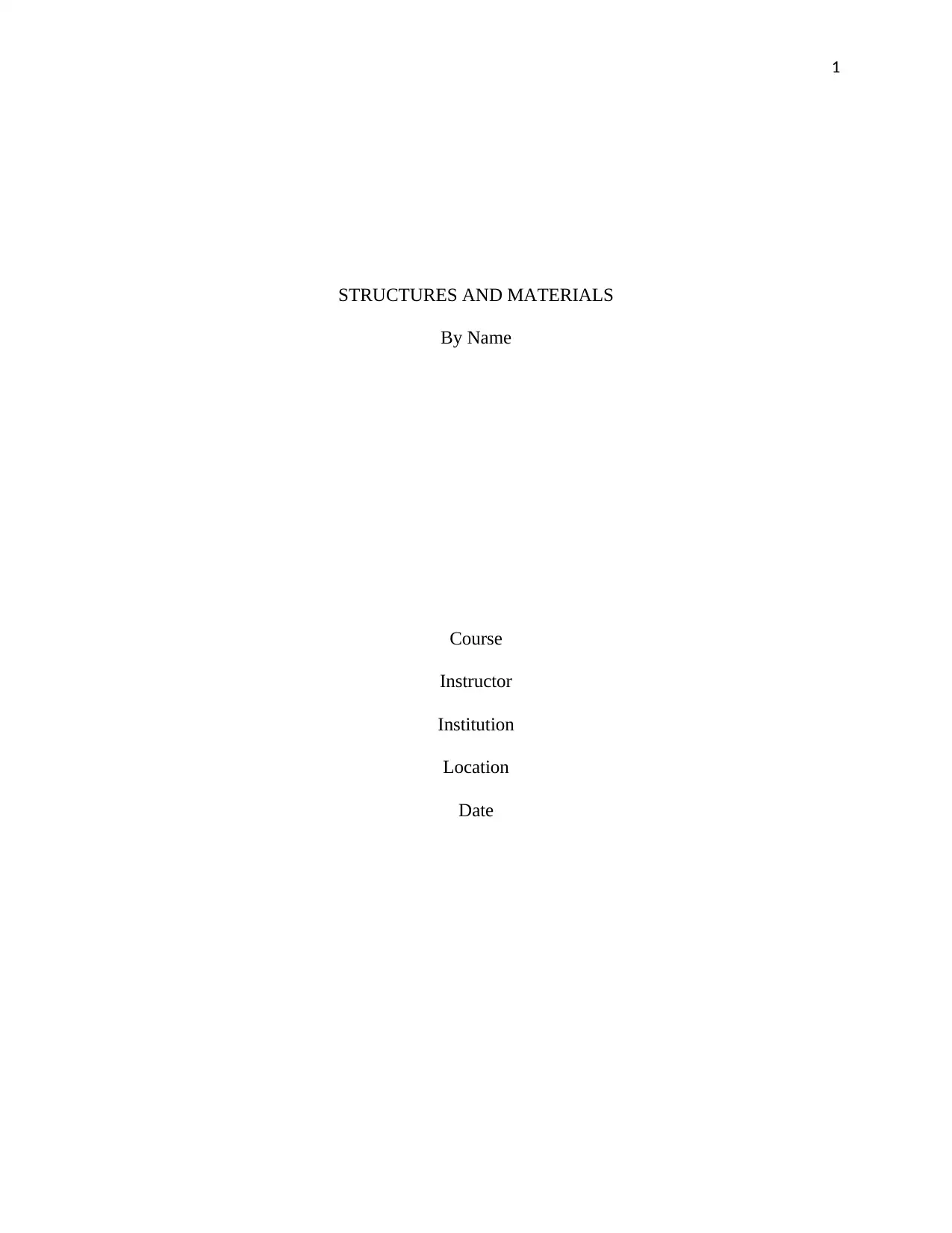
1
STRUCTURES AND MATERIALS
By Name
Course
Instructor
Institution
Location
Date
STRUCTURES AND MATERIALS
By Name
Course
Instructor
Institution
Location
Date
Paraphrase This Document
Need a fresh take? Get an instant paraphrase of this document with our AI Paraphraser
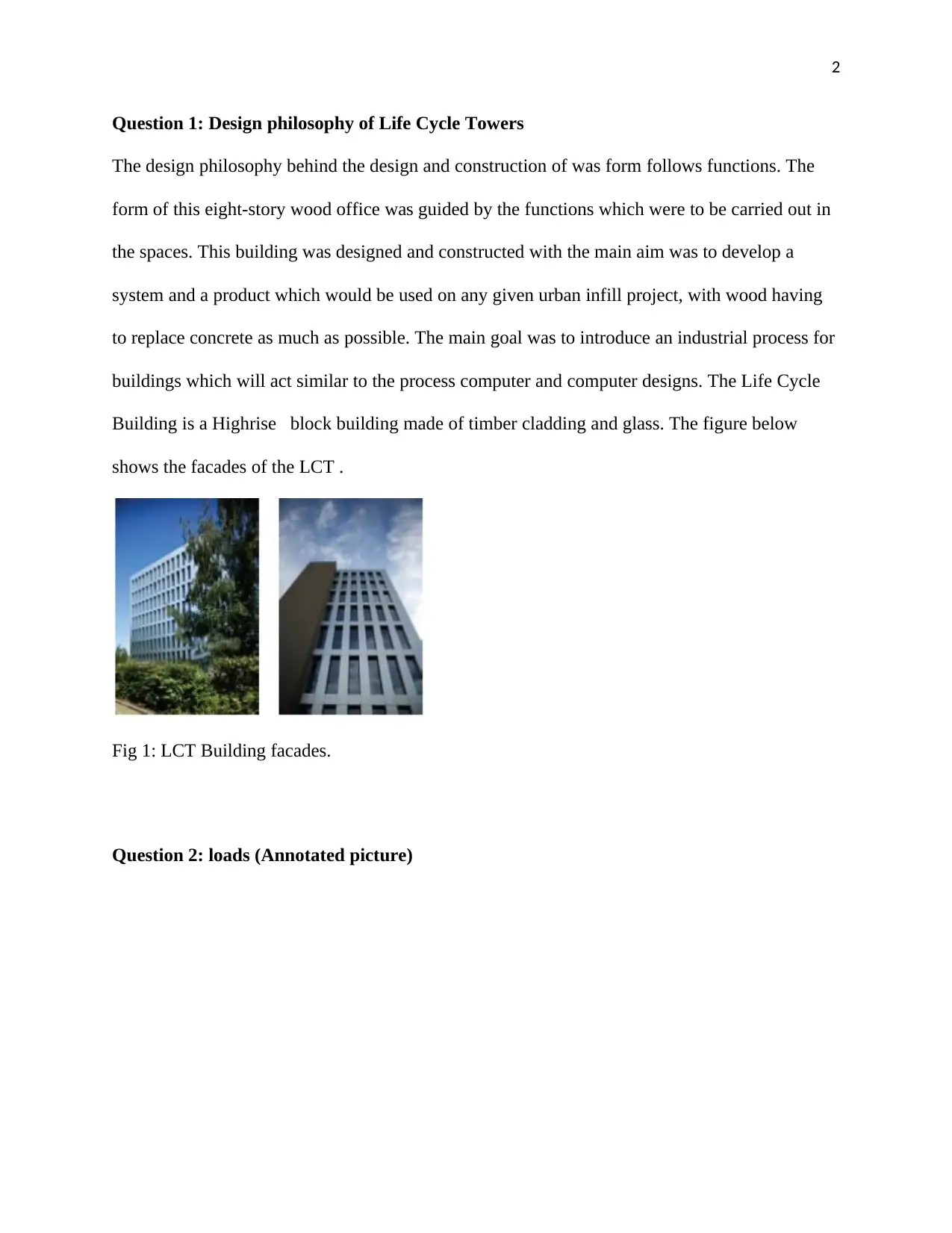
2
Question 1: Design philosophy of Life Cycle Towers
The design philosophy behind the design and construction of was form follows functions. The
form of this eight-story wood office was guided by the functions which were to be carried out in
the spaces. This building was designed and constructed with the main aim was to develop a
system and a product which would be used on any given urban infill project, with wood having
to replace concrete as much as possible. The main goal was to introduce an industrial process for
buildings which will act similar to the process computer and computer designs. The Life Cycle
Building is a Highrise block building made of timber cladding and glass. The figure below
shows the facades of the LCT .
Fig 1: LCT Building facades.
Question 2: loads (Annotated picture)
Question 1: Design philosophy of Life Cycle Towers
The design philosophy behind the design and construction of was form follows functions. The
form of this eight-story wood office was guided by the functions which were to be carried out in
the spaces. This building was designed and constructed with the main aim was to develop a
system and a product which would be used on any given urban infill project, with wood having
to replace concrete as much as possible. The main goal was to introduce an industrial process for
buildings which will act similar to the process computer and computer designs. The Life Cycle
Building is a Highrise block building made of timber cladding and glass. The figure below
shows the facades of the LCT .
Fig 1: LCT Building facades.
Question 2: loads (Annotated picture)
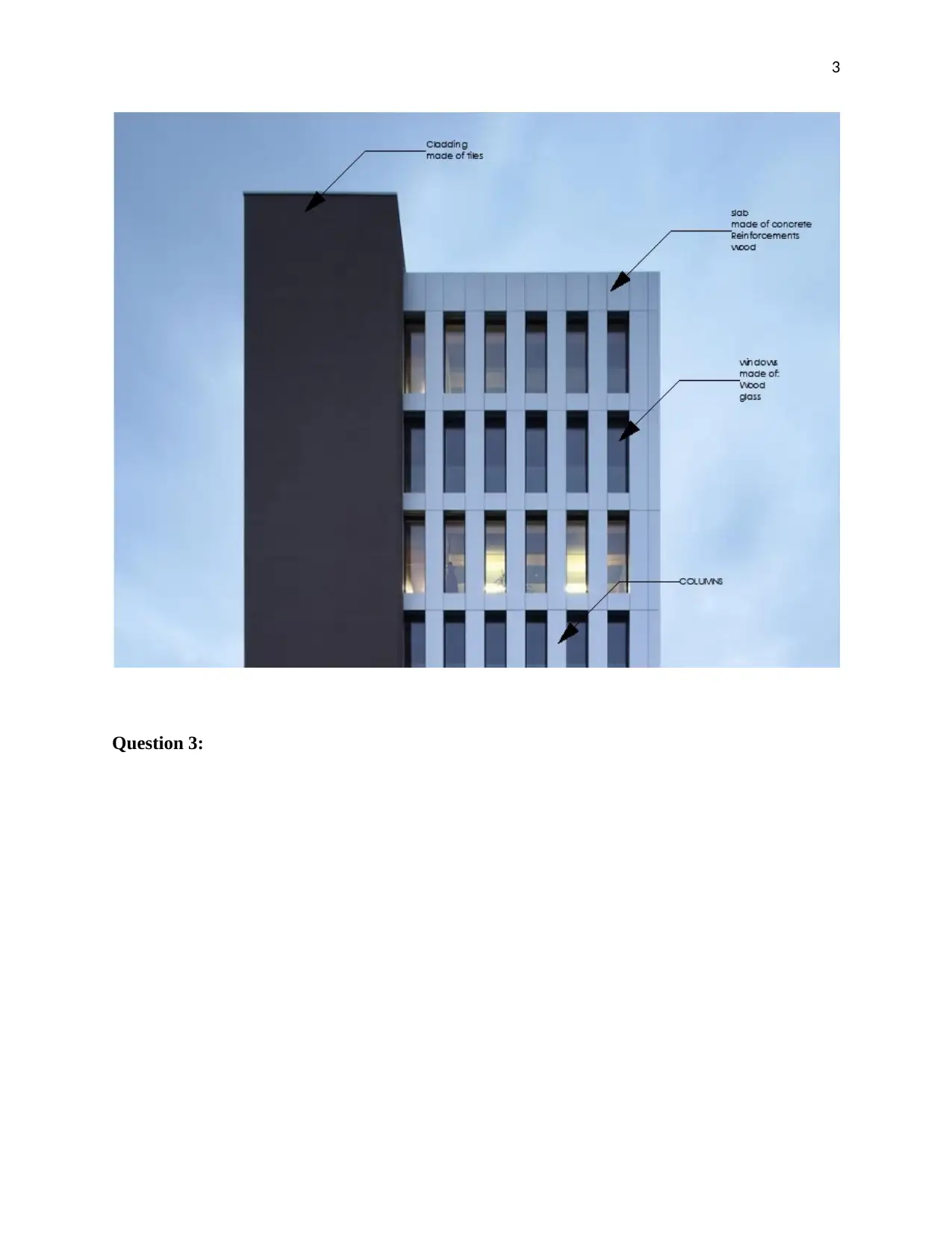
3
Question 3:
Question 3:
⊘ This is a preview!⊘
Do you want full access?
Subscribe today to unlock all pages.

Trusted by 1+ million students worldwide
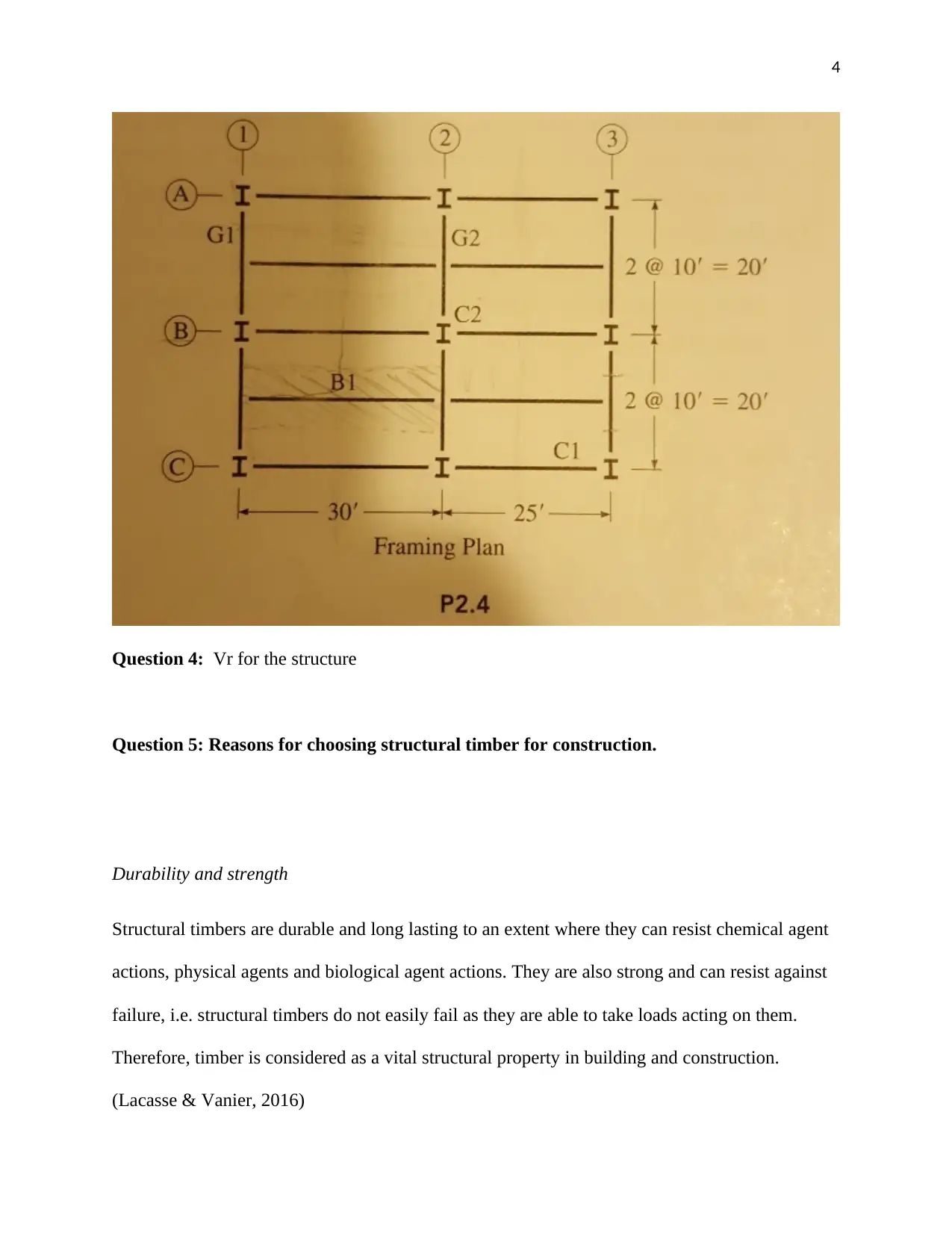
4
Question 4: Vr for the structure
Question 5: Reasons for choosing structural timber for construction.
Durability and strength
Structural timbers are durable and long lasting to an extent where they can resist chemical agent
actions, physical agents and biological agent actions. They are also strong and can resist against
failure, i.e. structural timbers do not easily fail as they are able to take loads acting on them.
Therefore, timber is considered as a vital structural property in building and construction.
(Lacasse & Vanier, 2016)
Question 4: Vr for the structure
Question 5: Reasons for choosing structural timber for construction.
Durability and strength
Structural timbers are durable and long lasting to an extent where they can resist chemical agent
actions, physical agents and biological agent actions. They are also strong and can resist against
failure, i.e. structural timbers do not easily fail as they are able to take loads acting on them.
Therefore, timber is considered as a vital structural property in building and construction.
(Lacasse & Vanier, 2016)
Paraphrase This Document
Need a fresh take? Get an instant paraphrase of this document with our AI Paraphraser
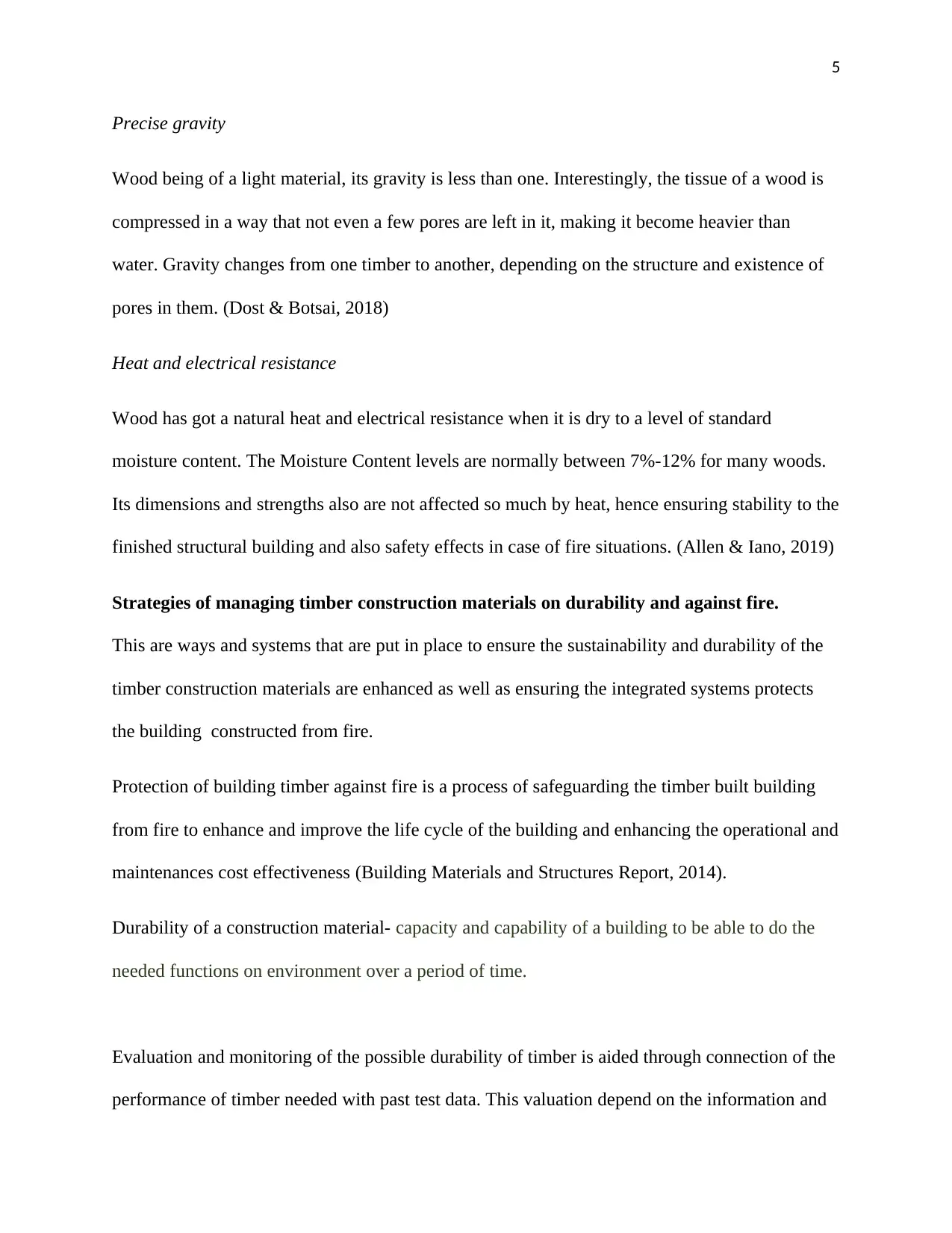
5
Precise gravity
Wood being of a light material, its gravity is less than one. Interestingly, the tissue of a wood is
compressed in a way that not even a few pores are left in it, making it become heavier than
water. Gravity changes from one timber to another, depending on the structure and existence of
pores in them. (Dost & Botsai, 2018)
Heat and electrical resistance
Wood has got a natural heat and electrical resistance when it is dry to a level of standard
moisture content. The Moisture Content levels are normally between 7%-12% for many woods.
Its dimensions and strengths also are not affected so much by heat, hence ensuring stability to the
finished structural building and also safety effects in case of fire situations. (Allen & Iano, 2019)
Strategies of managing timber construction materials on durability and against fire.
This are ways and systems that are put in place to ensure the sustainability and durability of the
timber construction materials are enhanced as well as ensuring the integrated systems protects
the building constructed from fire.
Protection of building timber against fire is a process of safeguarding the timber built building
from fire to enhance and improve the life cycle of the building and enhancing the operational and
maintenances cost effectiveness (Building Materials and Structures Report, 2014).
Durability of a construction material- capacity and capability of a building to be able to do the
needed functions on environment over a period of time.
Evaluation and monitoring of the possible durability of timber is aided through connection of the
performance of timber needed with past test data. This valuation depend on the information and
Precise gravity
Wood being of a light material, its gravity is less than one. Interestingly, the tissue of a wood is
compressed in a way that not even a few pores are left in it, making it become heavier than
water. Gravity changes from one timber to another, depending on the structure and existence of
pores in them. (Dost & Botsai, 2018)
Heat and electrical resistance
Wood has got a natural heat and electrical resistance when it is dry to a level of standard
moisture content. The Moisture Content levels are normally between 7%-12% for many woods.
Its dimensions and strengths also are not affected so much by heat, hence ensuring stability to the
finished structural building and also safety effects in case of fire situations. (Allen & Iano, 2019)
Strategies of managing timber construction materials on durability and against fire.
This are ways and systems that are put in place to ensure the sustainability and durability of the
timber construction materials are enhanced as well as ensuring the integrated systems protects
the building constructed from fire.
Protection of building timber against fire is a process of safeguarding the timber built building
from fire to enhance and improve the life cycle of the building and enhancing the operational and
maintenances cost effectiveness (Building Materials and Structures Report, 2014).
Durability of a construction material- capacity and capability of a building to be able to do the
needed functions on environment over a period of time.
Evaluation and monitoring of the possible durability of timber is aided through connection of the
performance of timber needed with past test data. This valuation depend on the information and
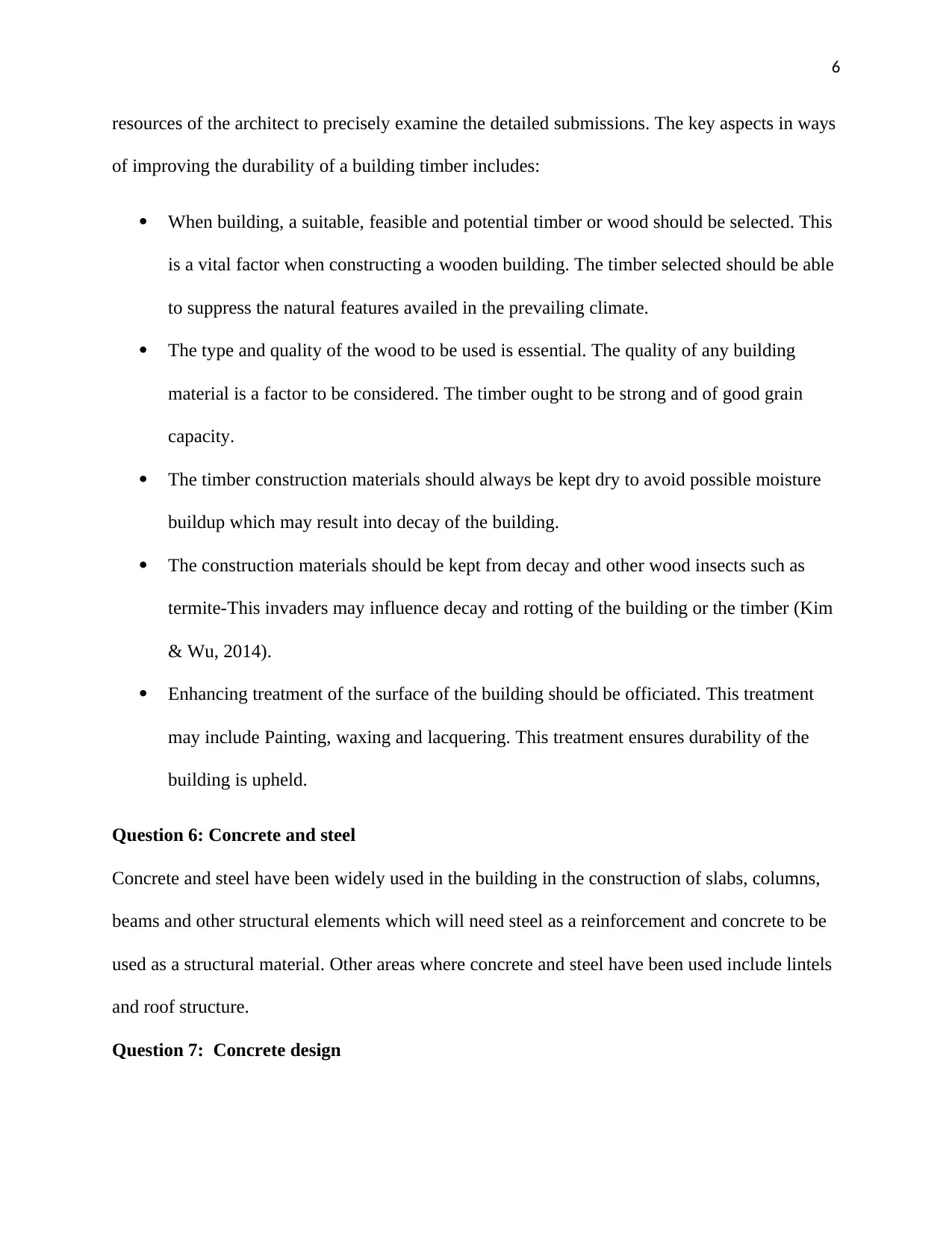
6
resources of the architect to precisely examine the detailed submissions. The key aspects in ways
of improving the durability of a building timber includes:
When building, a suitable, feasible and potential timber or wood should be selected. This
is a vital factor when constructing a wooden building. The timber selected should be able
to suppress the natural features availed in the prevailing climate.
The type and quality of the wood to be used is essential. The quality of any building
material is a factor to be considered. The timber ought to be strong and of good grain
capacity.
The timber construction materials should always be kept dry to avoid possible moisture
buildup which may result into decay of the building.
The construction materials should be kept from decay and other wood insects such as
termite-This invaders may influence decay and rotting of the building or the timber (Kim
& Wu, 2014).
Enhancing treatment of the surface of the building should be officiated. This treatment
may include Painting, waxing and lacquering. This treatment ensures durability of the
building is upheld.
Question 6: Concrete and steel
Concrete and steel have been widely used in the building in the construction of slabs, columns,
beams and other structural elements which will need steel as a reinforcement and concrete to be
used as a structural material. Other areas where concrete and steel have been used include lintels
and roof structure.
Question 7: Concrete design
resources of the architect to precisely examine the detailed submissions. The key aspects in ways
of improving the durability of a building timber includes:
When building, a suitable, feasible and potential timber or wood should be selected. This
is a vital factor when constructing a wooden building. The timber selected should be able
to suppress the natural features availed in the prevailing climate.
The type and quality of the wood to be used is essential. The quality of any building
material is a factor to be considered. The timber ought to be strong and of good grain
capacity.
The timber construction materials should always be kept dry to avoid possible moisture
buildup which may result into decay of the building.
The construction materials should be kept from decay and other wood insects such as
termite-This invaders may influence decay and rotting of the building or the timber (Kim
& Wu, 2014).
Enhancing treatment of the surface of the building should be officiated. This treatment
may include Painting, waxing and lacquering. This treatment ensures durability of the
building is upheld.
Question 6: Concrete and steel
Concrete and steel have been widely used in the building in the construction of slabs, columns,
beams and other structural elements which will need steel as a reinforcement and concrete to be
used as a structural material. Other areas where concrete and steel have been used include lintels
and roof structure.
Question 7: Concrete design
⊘ This is a preview!⊘
Do you want full access?
Subscribe today to unlock all pages.

Trusted by 1+ million students worldwide
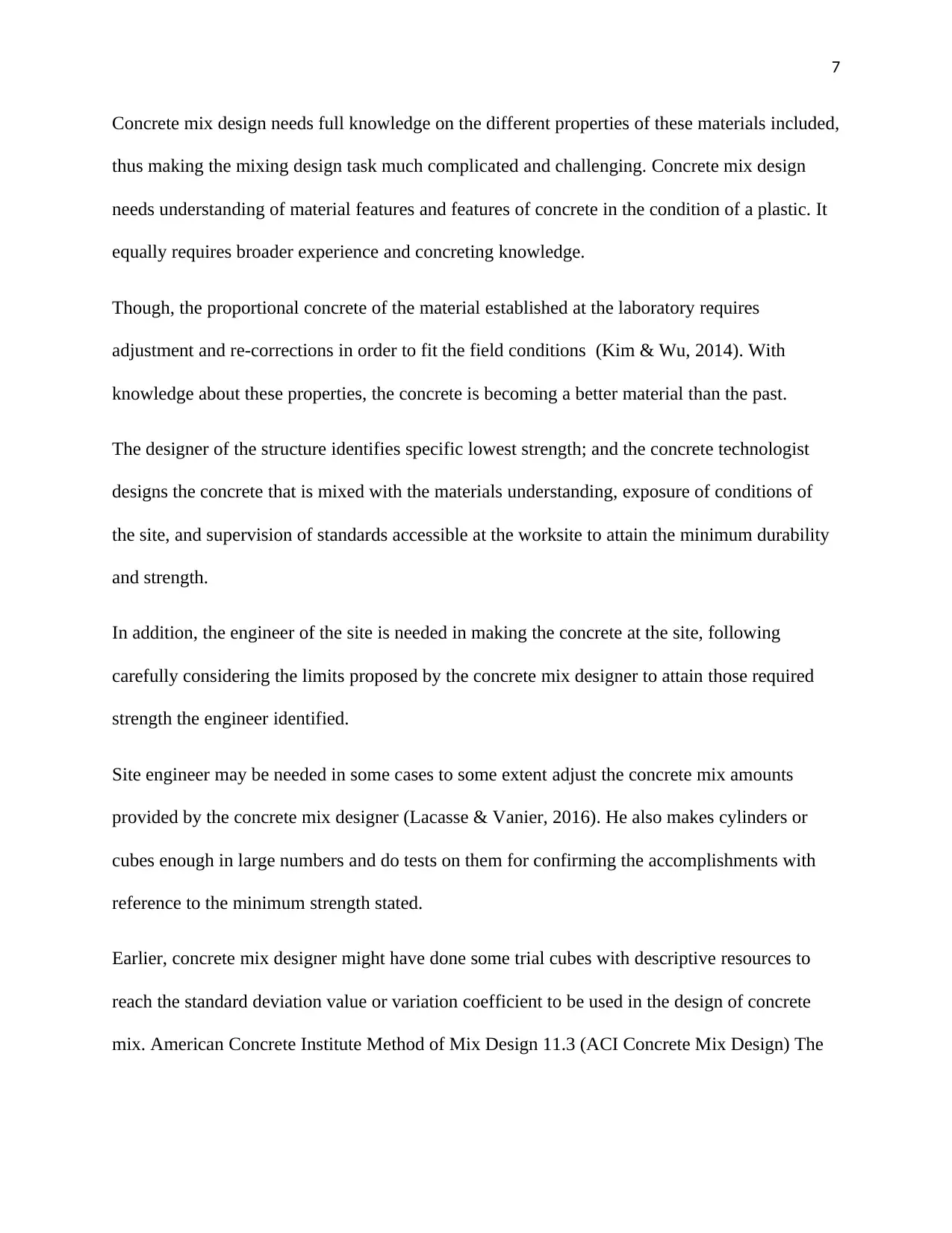
7
Concrete mix design needs full knowledge on the different properties of these materials included,
thus making the mixing design task much complicated and challenging. Concrete mix design
needs understanding of material features and features of concrete in the condition of a plastic. It
equally requires broader experience and concreting knowledge.
Though, the proportional concrete of the material established at the laboratory requires
adjustment and re-corrections in order to fit the field conditions (Kim & Wu, 2014). With
knowledge about these properties, the concrete is becoming a better material than the past.
The designer of the structure identifies specific lowest strength; and the concrete technologist
designs the concrete that is mixed with the materials understanding, exposure of conditions of
the site, and supervision of standards accessible at the worksite to attain the minimum durability
and strength.
In addition, the engineer of the site is needed in making the concrete at the site, following
carefully considering the limits proposed by the concrete mix designer to attain those required
strength the engineer identified.
Site engineer may be needed in some cases to some extent adjust the concrete mix amounts
provided by the concrete mix designer (Lacasse & Vanier, 2016). He also makes cylinders or
cubes enough in large numbers and do tests on them for confirming the accomplishments with
reference to the minimum strength stated.
Earlier, concrete mix designer might have done some trial cubes with descriptive resources to
reach the standard deviation value or variation coefficient to be used in the design of concrete
mix. American Concrete Institute Method of Mix Design 11.3 (ACI Concrete Mix Design) The
Concrete mix design needs full knowledge on the different properties of these materials included,
thus making the mixing design task much complicated and challenging. Concrete mix design
needs understanding of material features and features of concrete in the condition of a plastic. It
equally requires broader experience and concreting knowledge.
Though, the proportional concrete of the material established at the laboratory requires
adjustment and re-corrections in order to fit the field conditions (Kim & Wu, 2014). With
knowledge about these properties, the concrete is becoming a better material than the past.
The designer of the structure identifies specific lowest strength; and the concrete technologist
designs the concrete that is mixed with the materials understanding, exposure of conditions of
the site, and supervision of standards accessible at the worksite to attain the minimum durability
and strength.
In addition, the engineer of the site is needed in making the concrete at the site, following
carefully considering the limits proposed by the concrete mix designer to attain those required
strength the engineer identified.
Site engineer may be needed in some cases to some extent adjust the concrete mix amounts
provided by the concrete mix designer (Lacasse & Vanier, 2016). He also makes cylinders or
cubes enough in large numbers and do tests on them for confirming the accomplishments with
reference to the minimum strength stated.
Earlier, concrete mix designer might have done some trial cubes with descriptive resources to
reach the standard deviation value or variation coefficient to be used in the design of concrete
mix. American Concrete Institute Method of Mix Design 11.3 (ACI Concrete Mix Design) The
Paraphrase This Document
Need a fresh take? Get an instant paraphrase of this document with our AI Paraphraser
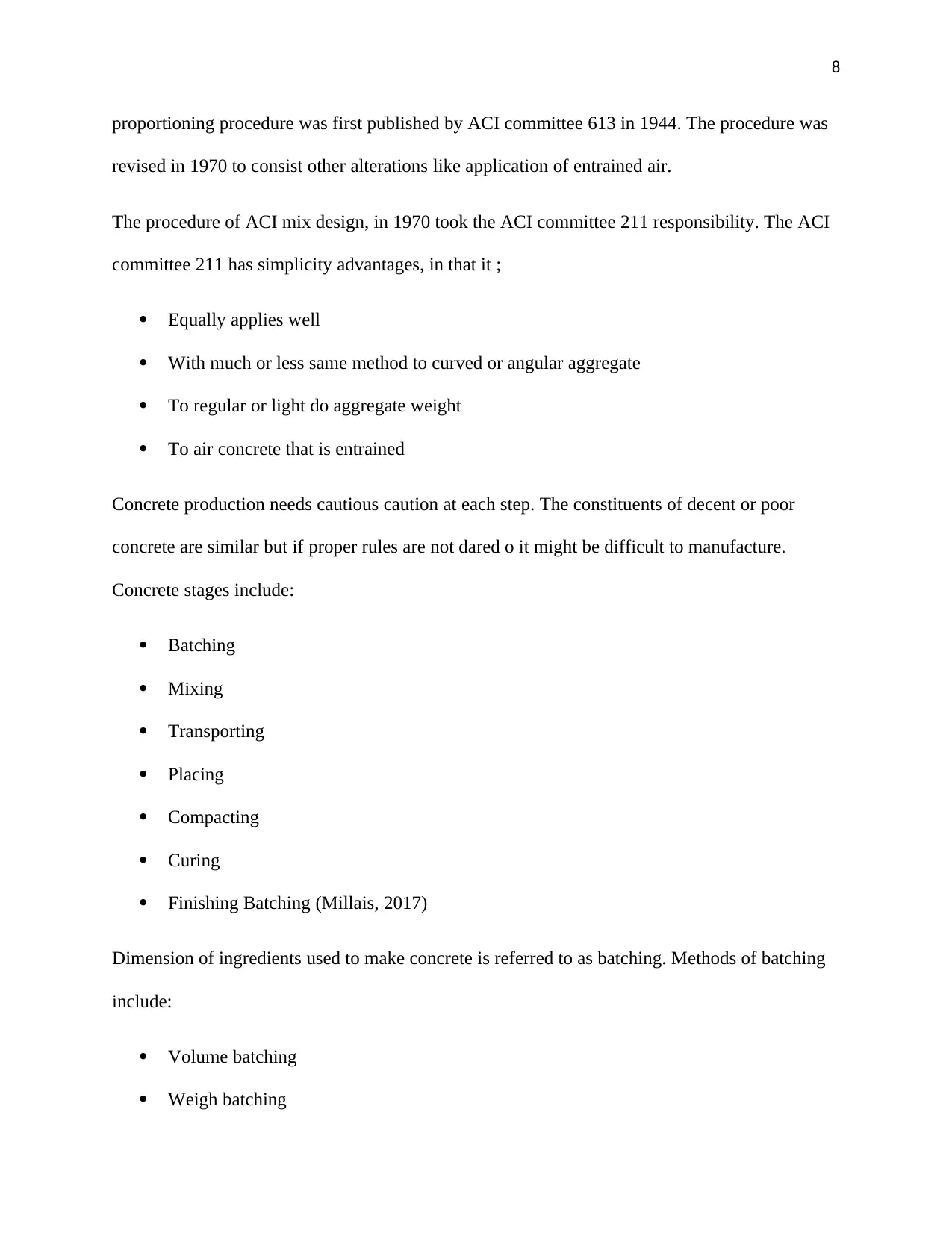
8
proportioning procedure was first published by ACI committee 613 in 1944. The procedure was
revised in 1970 to consist other alterations like application of entrained air.
The procedure of ACI mix design, in 1970 took the ACI committee 211 responsibility. The ACI
committee 211 has simplicity advantages, in that it ;
Equally applies well
With much or less same method to curved or angular aggregate
To regular or light do aggregate weight
To air concrete that is entrained
Concrete production needs cautious caution at each step. The constituents of decent or poor
concrete are similar but if proper rules are not dared o it might be difficult to manufacture.
Concrete stages include:
Batching
Mixing
Transporting
Placing
Compacting
Curing
Finishing Batching (Millais, 2017)
Dimension of ingredients used to make concrete is referred to as batching. Methods of batching
include:
Volume batching
Weigh batching
proportioning procedure was first published by ACI committee 613 in 1944. The procedure was
revised in 1970 to consist other alterations like application of entrained air.
The procedure of ACI mix design, in 1970 took the ACI committee 211 responsibility. The ACI
committee 211 has simplicity advantages, in that it ;
Equally applies well
With much or less same method to curved or angular aggregate
To regular or light do aggregate weight
To air concrete that is entrained
Concrete production needs cautious caution at each step. The constituents of decent or poor
concrete are similar but if proper rules are not dared o it might be difficult to manufacture.
Concrete stages include:
Batching
Mixing
Transporting
Placing
Compacting
Curing
Finishing Batching (Millais, 2017)
Dimension of ingredients used to make concrete is referred to as batching. Methods of batching
include:
Volume batching
Weigh batching
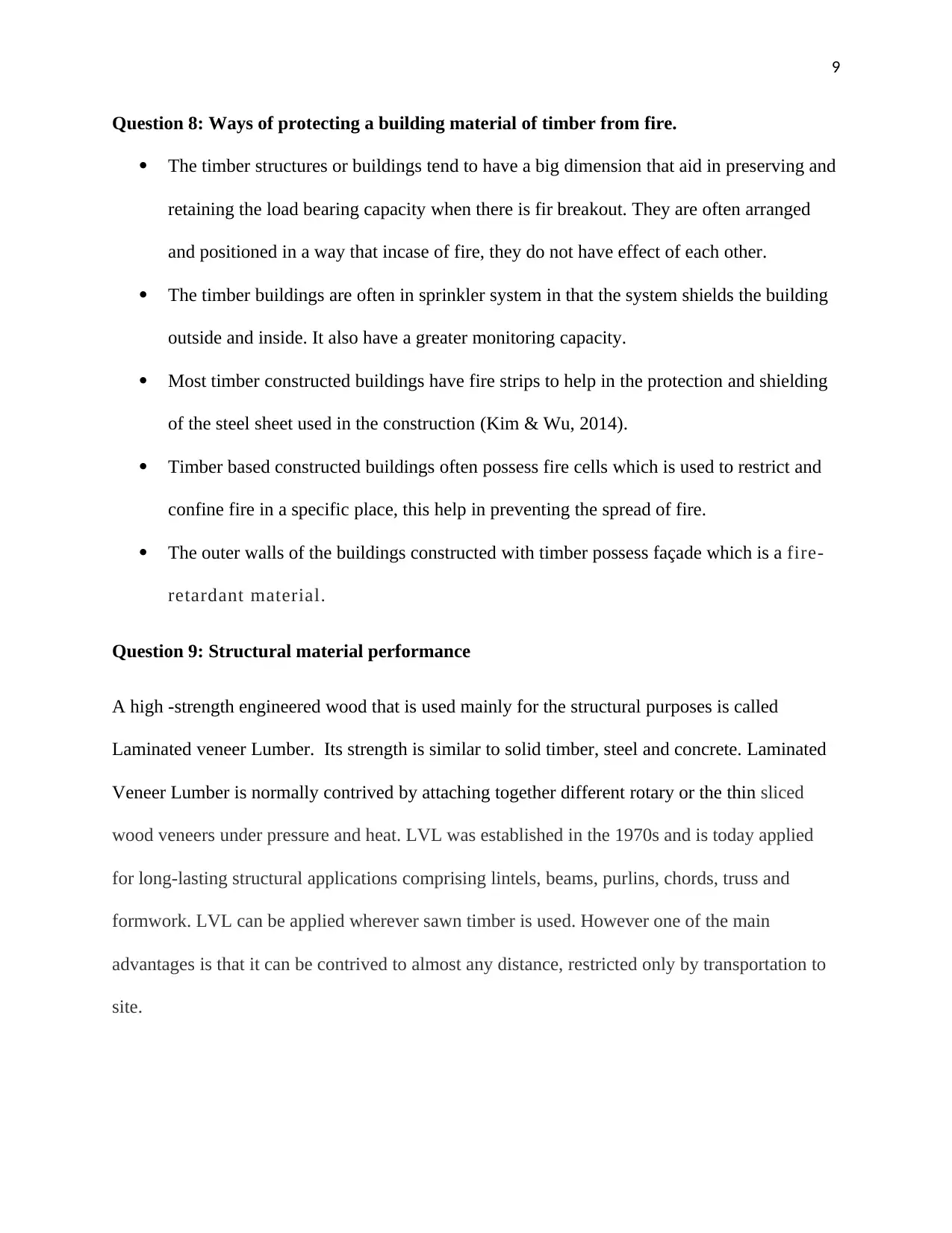
9
Question 8: Ways of protecting a building material of timber from fire.
The timber structures or buildings tend to have a big dimension that aid in preserving and
retaining the load bearing capacity when there is fir breakout. They are often arranged
and positioned in a way that incase of fire, they do not have effect of each other.
The timber buildings are often in sprinkler system in that the system shields the building
outside and inside. It also have a greater monitoring capacity.
Most timber constructed buildings have fire strips to help in the protection and shielding
of the steel sheet used in the construction (Kim & Wu, 2014).
Timber based constructed buildings often possess fire cells which is used to restrict and
confine fire in a specific place, this help in preventing the spread of fire.
The outer walls of the buildings constructed with timber possess façade which is a fire-
retardant material.
Question 9: Structural material performance
A high -strength engineered wood that is used mainly for the structural purposes is called
Laminated veneer Lumber. Its strength is similar to solid timber, steel and concrete. Laminated
Veneer Lumber is normally contrived by attaching together different rotary or the thin sliced
wood veneers under pressure and heat. LVL was established in the 1970s and is today applied
for long-lasting structural applications comprising lintels, beams, purlins, chords, truss and
formwork. LVL can be applied wherever sawn timber is used. However one of the main
advantages is that it can be contrived to almost any distance, restricted only by transportation to
site.
Question 8: Ways of protecting a building material of timber from fire.
The timber structures or buildings tend to have a big dimension that aid in preserving and
retaining the load bearing capacity when there is fir breakout. They are often arranged
and positioned in a way that incase of fire, they do not have effect of each other.
The timber buildings are often in sprinkler system in that the system shields the building
outside and inside. It also have a greater monitoring capacity.
Most timber constructed buildings have fire strips to help in the protection and shielding
of the steel sheet used in the construction (Kim & Wu, 2014).
Timber based constructed buildings often possess fire cells which is used to restrict and
confine fire in a specific place, this help in preventing the spread of fire.
The outer walls of the buildings constructed with timber possess façade which is a fire-
retardant material.
Question 9: Structural material performance
A high -strength engineered wood that is used mainly for the structural purposes is called
Laminated veneer Lumber. Its strength is similar to solid timber, steel and concrete. Laminated
Veneer Lumber is normally contrived by attaching together different rotary or the thin sliced
wood veneers under pressure and heat. LVL was established in the 1970s and is today applied
for long-lasting structural applications comprising lintels, beams, purlins, chords, truss and
formwork. LVL can be applied wherever sawn timber is used. However one of the main
advantages is that it can be contrived to almost any distance, restricted only by transportation to
site.
⊘ This is a preview!⊘
Do you want full access?
Subscribe today to unlock all pages.

Trusted by 1+ million students worldwide
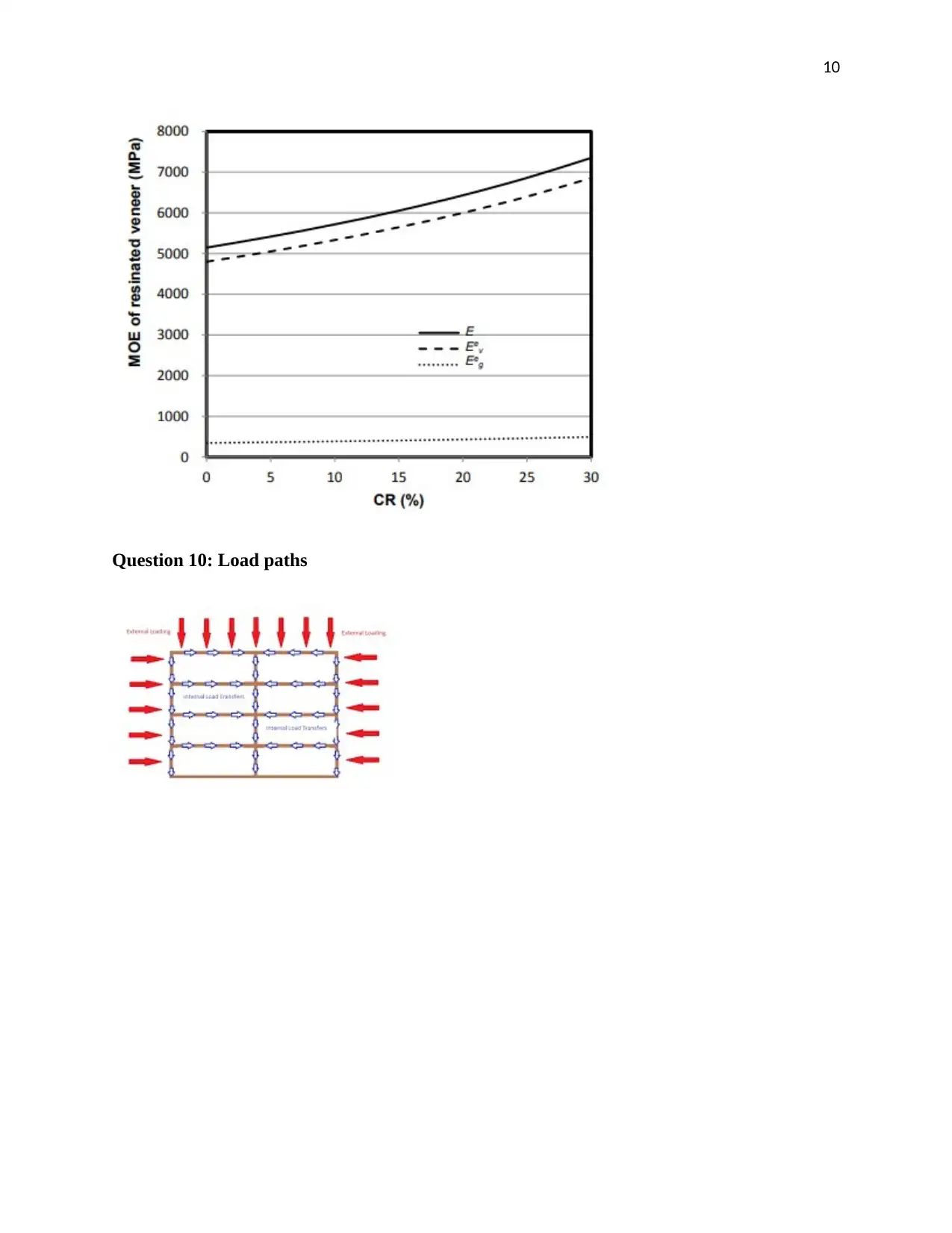
10
Question 10: Load paths
Question 10: Load paths
Paraphrase This Document
Need a fresh take? Get an instant paraphrase of this document with our AI Paraphraser
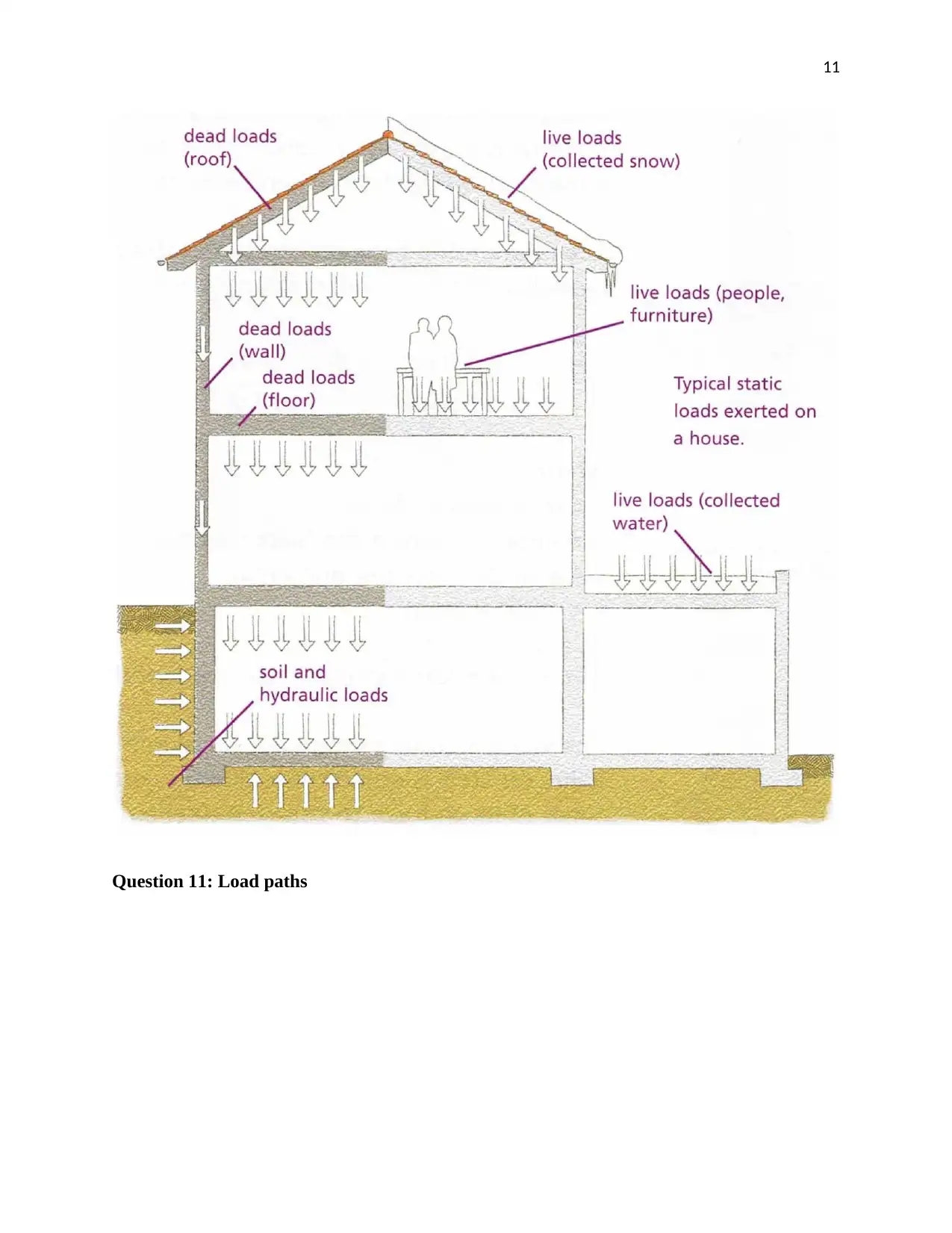
11
Question 11: Load paths
Question 11: Load paths
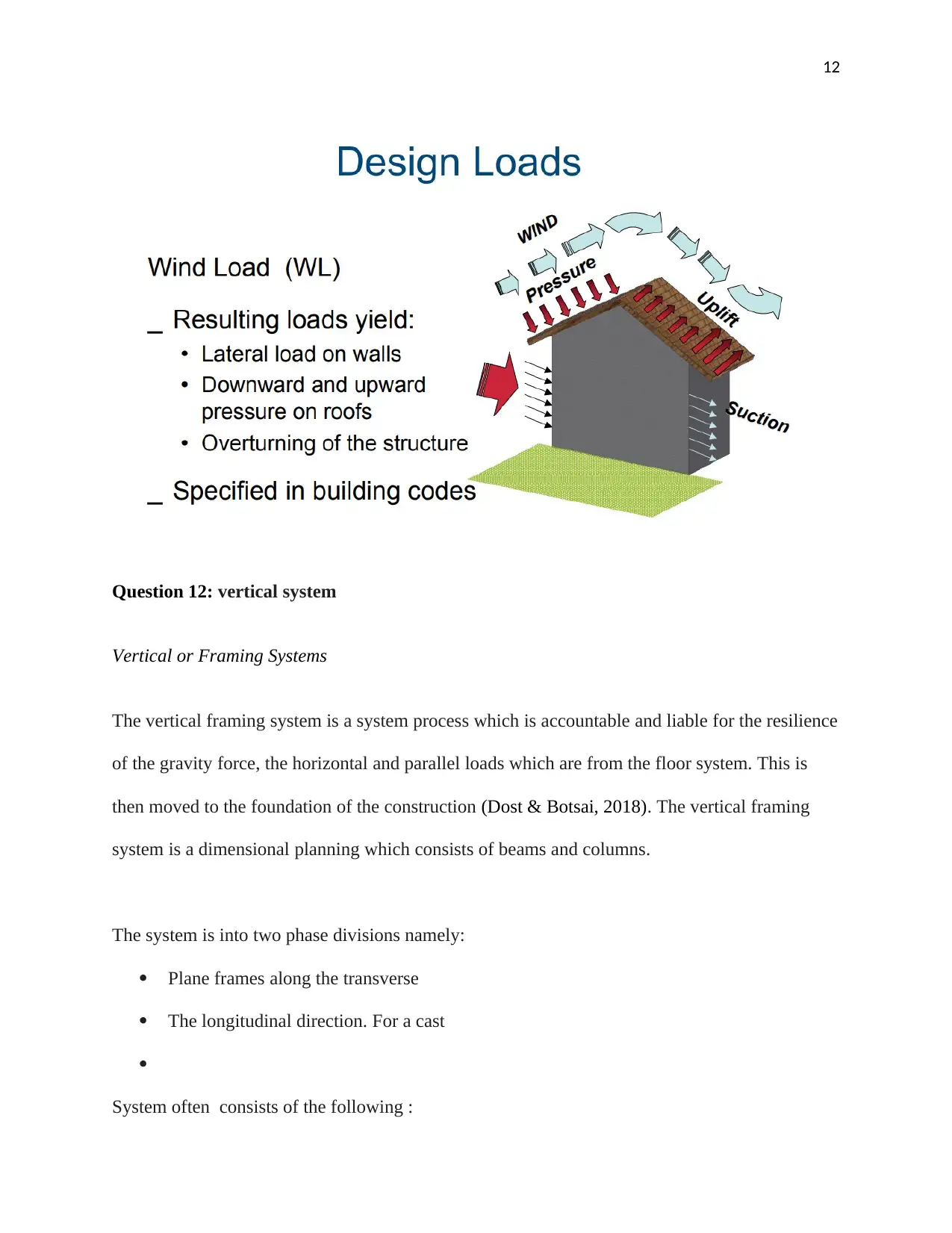
12
Question 12: vertical system
Vertical or Framing Systems
The vertical framing system is a system process which is accountable and liable for the resilience
of the gravity force, the horizontal and parallel loads which are from the floor system. This is
then moved to the foundation of the construction (Dost & Botsai, 2018). The vertical framing
system is a dimensional planning which consists of beams and columns.
The system is into two phase divisions namely:
Plane frames along the transverse
The longitudinal direction. For a cast
System often consists of the following :
Question 12: vertical system
Vertical or Framing Systems
The vertical framing system is a system process which is accountable and liable for the resilience
of the gravity force, the horizontal and parallel loads which are from the floor system. This is
then moved to the foundation of the construction (Dost & Botsai, 2018). The vertical framing
system is a dimensional planning which consists of beams and columns.
The system is into two phase divisions namely:
Plane frames along the transverse
The longitudinal direction. For a cast
System often consists of the following :
⊘ This is a preview!⊘
Do you want full access?
Subscribe today to unlock all pages.

Trusted by 1+ million students worldwide
1 out of 20
Your All-in-One AI-Powered Toolkit for Academic Success.
+13062052269
info@desklib.com
Available 24*7 on WhatsApp / Email
![[object Object]](/_next/static/media/star-bottom.7253800d.svg)
Unlock your academic potential
Copyright © 2020–2025 A2Z Services. All Rights Reserved. Developed and managed by ZUCOL.


